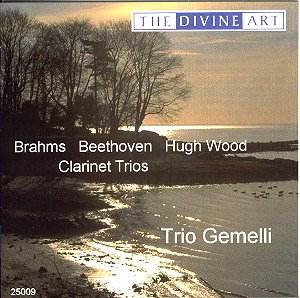This disc comes from a fairly new stable, where a reputation
for good recordings is growing.
The coupling is decidedly unusual: those in tune with
Brahms and Beethoven will not be necessarily appreciative of Wood and
vice versa. Both the Brahms and Beethoven works have a large number
of recordings in the catalogue (over 25 for the Brahms alone) while
the Wood makes its debut here as a première recording.
The Brahms and Beethoven Trios played by members of
the New Vienna Octet (1981) are still regarded highly as benchmark performances.
But the youthful Gemelli Trio (not to be confused with Gabrieli Quartet)
has a quality of performance that should not be lightly dismissed from
one's choice. Here the presence is more 'modern' than many of the previous
recordings, and a marked clarity is matched by a careful balance between
instruments. The playing is particularly sensitive: I like the delicately
handled dynamics of the Emily Segal's piano in works like the Brahms,
which can often be too intrusive.
The skilful reading by the Bradburys is superb, and
in fact the team work effectively to convey nuances of mood.
While the Beethoven Trio was written when the
composer was at a zenith of vitality, the Brahms was written by a mature
and skilled master of composition at the end of his career. In the Brahms,
the dreamy Adagio is strongly engaging [tk.2] and needs to be heard
in a receptive environment to fully appreciate the careful preparation
for this recording.
The Wood piece to me might be summed up as a
work 'with roaming keys' and tends to be sterile in depicting any of
my nameable emotions. The complexities of the score are ably handled
by the Trio, and Adrian's cello handles difficult high notes with skill.
Where a held note on the piano is picked up by the clarinet, the crossover
cannot be detected, the musicianship and balance is that good.
After the weight of the Wood, the Beethoven Trio
follows like a breath of fresh air. Schubert and Beethoven have something
to share in the style of the delicious Allegro con brio and Allegretto
[tk.10]. This piece requires deft fingerwork at the piano, which Segal
handles masterfully.
The recital is given in warm acoustics, not dry and
not so reverberant that staccato chords are picked up with an annoying
ricocheting effect. At times one thinks that a group larger than a trio
is providing the music.
With stiff competition around it is difficult to say
how the disc will fare. The coupling will be a decisive factor, but
one wishes it well.
A good set of notes is included in both English and
German.
Raymond Walker
